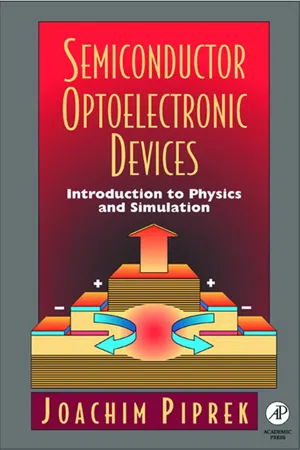
Semiconductor Optoelectronic Devices
Introduction to Physics and Simulation
- 279 pages
- English
- ePUB (mobile friendly)
- Available on iOS & Android
About This Book
Optoelectronics has become an important part of our lives. Wherever light is used to transmit information, tiny semiconductor devices are needed to transfer electrical current into optical signals and vice versa. Examples include light emitting diodes in radios and other appliances, photodetectors in elevator doors and digital cameras, and laser diodes that transmit phone calls through glass fibers. Such optoelectronic devices take advantage of sophisticated interactions between electrons and light. Nanometer scale semiconductor structures are often at the heart of modern optoelectronic devices. Their shrinking size and increasing complexity make computer simulation an important tool to design better devices that meet ever rising perfomance requirements. The current need to apply advanced design software in optoelectronics follows the trend observed in the 1980's with simulation software for silicon devices. Today, software for technology computer-aided design (TCAD) and electronic design automation (EDA) represents a fundamental part of the silicon industry. In optoelectronics, advanced commercial device software has emerged recently and it is expected to play an increasingly important role in the near future. This book will enable students, device engineers, and researchers to more effectively use advanced design software in optoelectronics.
- Provides fundamental knowledge in semiconductor physics and in electromagnetics, while helping to understand and use advanced device simulation software
- Demonstrates the combination of measurements and simulations in order to obtain realistic results and provides data on all required material parameters
- Gives deep insight into the physics of state-of-the-art devices and helps to design and analyze of modern optoelectronic devices
Frequently asked questions
Information
Table of contents
- Cover image
- Title page
- Table of Contents
- Copyright
- Dedication
- Preface
- Chapter 1: Introduction to Semiconductors
- Chapter 2: Electron Energy Bands
- Chapter 3: Carrier Transport
- Chapter 4: Optical Waves
- Chapter 5: Photon Generation
- Chapter 6: Heat Generation and Dissipation
- Chapter 7: Edge-Emitting Laser
- Chapter 8: Vertical-Cavity Laser
- Chapter 9: Nitride Light Emitters
- Chapter 10: Electroabsorption Modulator
- Chapter 11: Amplification Photodetector
- Constants and Units
- Basic Mathematical Relations
- Symbols and Abbreviations
- Bibliography
- Index